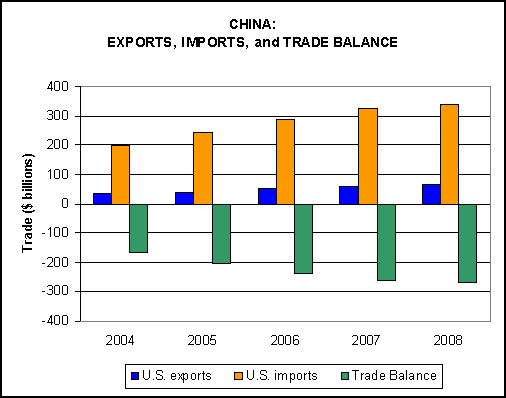View Section in Publication :: Return to Overview

Key Economic Trends
- While the growth of U.S. exports to China continued to outpace the growth of U.S. imports in 2008, the U.S. trade deficit with China increased by 3 percent to $270.3 billion. For the second consecutive year, China was the single-largest source of U.S. imports and the third-largest market for U.S. exports.
- Agricultural exports, primarily soybeans, accounted for over one-half of the overall increase in U.S. exports to China in 2008, due to the rising global prices of agricultural commodities.
- Manufacturing, particularly by foreign-based enterprises engaged in processing trade, has been the driving force behind China's export-oriented economy in recent years. Chinese operations have become increasingly integrated into global production chains by supplying relatively low-wage labor for the final assembly of products.
- Industry/commodity groups contributing most to the $14.4 billion (5 percent) increase in U.S. imports from China in 2008 were television receivers and video monitors; steel mill products; organic specialty chemicals; toys and games; and coal, coke, and related chemical products.
Trade Shifts in 2008 from 2007
- U.S. trade deficit: Increased by $8.3 billion (3 percent) to $270.3 billion
- U.S. exports: Increased by $6.2 billion (10 percent) to $67.2 billion
- U.S. imports: Increased by $14.4 billion (5 percent) to $337.5 billion
Other Government Resources
U.S. Central Intelligence Agency
World Factbook:China
World Trade Organization
Trade Policy Review--China
Peoples Republic of China
Ministry of Commerce
Ministry of Foreign Affairs, Office of North America and Oceania
U.S. Department of Commerce
China Business Information Center: US Government Resources for Exporting to China
Office of China Economic Area


















